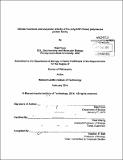Cellular functions and enzymatic activity of the poly(ADP-ribose) polymerase protein family
Author(s)
Vyas, Sejal (Sejal Kamlesh)
DownloadFull printable version (21.15Mb)
Other Contributors
Massachusetts Institute of Technology. Department of Biology.
Advisor
Paul Chang.
Terms of use
Metadata
Show full item recordAbstract
The poly(ADP-ribose) polymerase (PARP) protein family consists of seventeen enzymes and generates ADP-ribose (ADPr) posttranslational modifications onto target proteins using NAD* as a substrate. While functions for PARPs in the nucleus, such as in DNA damage repair and transcriptional regulation, had been well studied, functions for PARPs outside the nucleus were largely unknown. The well known product of PARP activity is poly(ADP-ribose) (PAR), which is a structurally complex polymer that can be up to 200 units in length. Because the PARP family was identified based on sequence homology to the catalytic domain of PARP1, the founding PARP member and main generator of nuclear PAR modifications, it was thought that the remaining family members also synthesize PAR. However, bioinformatics analysis has predicted that many PARPs in fact generate only mono(ADP-ribose) (MAR) modifications. As yet, the catalytic activity of for the entire PARP family has not been experimentally verified. We performed a systematic analysis of the PARP family to identify novel functions and determine the enzymatic activity for each PARP. First a family-wide localization and RNAi screen was performed to identify novel functions for PARP family members. From this work, we determined that the majority of PARPs are cytoplasmic and discovered new cytoplasmic functions for PARPs including actin cytoskeleton regulation and in regulation of membrane bound organelle structures. The enzymatic activity of each PARP was then analyzed to determine which types of ADPr modifications may be required for the PARP functions identified. We found that the majority of the PARP family proteins generate MAR modifications. Together, this work advances the understanding of PARP biology and identified novel PARP functions.
Description
Thesis: Ph. D., Massachusetts Institute of Technology, Department of Biology, 2014. Cataloged from PDF version of thesis. Vita. Includes bibliographical references.
Date issued
2014Department
Massachusetts Institute of Technology. Department of BiologyPublisher
Massachusetts Institute of Technology
Keywords
Biology.